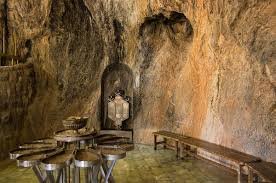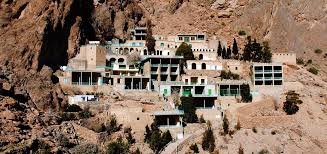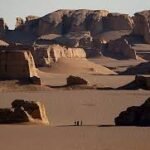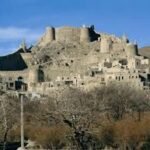Perched dramatically on a sheer cliff face in Iran’s central desert, the Chak Chak Fire Temple represents one of Zoroastrianism’s most sacred sites, where a natural spring and eternal flame have drawn pilgrims for over fifteen centuries. Known as Pir-e Sabz (“The Green Saint”) to devotees, this remote sanctuary clings to the mountainside 68 kilometers from Yazd, its whitewashed structures blending seamlessly into the rocky outcrops. According to legend, the temple marks where Princess Nikbanou, daughter of the last pre-Islamic Persian emperor, fled Arab invaders in 640 CE and was miraculously swallowed by the mountain, which then began weeping the eternal spring that gives the site its onomatopoeic name (“drip-drip” in Persian). Today, the temple’s sacred fire – said to have burned continuously since Sassanian times – illuminates an extraordinary fusion of natural wonder and spiritual devotion in one of the world’s most extreme environments.
The Miracle of the Weeping Mountain
Chak Chak’s central wonder is its life-giving water source in an otherwise arid landscape. The mountain seeps water year-round from its limestone pores, collecting in a sacred basin where pilgrims drink and perform rituals. Geologists have determined the water travels through ancient underground channels from the nearby Mount Khajeh, filtered through mineral-rich strata that give it a distinctive sweet taste. The most remarkable phenomenon occurs during the annual June pilgrimage, when the water flow mysteriously increases tenfold without apparent cause, cascading down the cliff in a silver veil. Zoroastrians interpret this as the mountain’s emotional response to visitors’ prayers, while scientists attribute it to snowmelt patterns and capillary action in the porous rock. Either way, the sight of this desert waterfall – however brief – creates an unforgettable spectacle against the burnt orange cliffs.
Architecture of Devotion: Temple Built Into the Rock
The temple complex showcases ingenious adaptation to its vertical setting. The main sanctuary is carved directly into the mountain, with silver doors leading to an inner grotto where the eternal flame burns behind glass. A massive ancient tree grows improbably from the cliffside, its roots entwined with the structure’s supporting beams. The site features:
- A ceremonial stairway of 365 steps (one for each day of the Zoroastrian calendar)
- A reflecting pool that captures both firelight and water ripples
- Stone platforms where priests perform seasonal rituals
- Ancient oil lamps set into natural rock niches
The most striking feature is the “Dokhma Terrace,” where traditional sky burials were once performed, though this practice ceased in the 1970s. Restoration work in 2018 revealed hidden chambers containing Sassanian-era fire urns and ritual objects, now displayed in the temple’s small museum.
The Eternal Flame’s Secret Keepers
At Chak Chak’s heart burns the Atash Bahram (“Victorious Fire”), one of only eight Zoroastrian fires of its grade worldwide. Fed by sandalwood and frankincense five times daily, the flame is tended by hereditary priests from the nearby Sharifabad village. The current caretaker family traces their lineage to 14th-century mobeds (priests) who smuggled the sacred fire from Pars during Islamic conquests. Their oral traditions describe secretly transporting the flame in a bronze vessel disguised as a cooking pot, hiding in mountain caves for seven years before establishing the current temple. The fire’s continuity has allegedly never broken, even during earthquakes and invasions. In 2013, scientists analyzing the ashes discovered traces of rare myrrh species from Somalia, evidence of ancient trade routes connecting this remote shrine to distant lands.
Pilgrimage Traditions and Living Rituals
Each June, Zoroastrians from India, Iran and worldwide converge for the 18-day Tirgan festival. Pilgrims ascend the mountain barefoot, chanting ancient Avestan prayers, before performing the “sedreh pushun” ceremony where they tie sacred wool cords around the cliffside tree. The most moving ritual occurs at dusk, when hundreds of oil lamps are lit simultaneously, creating a cascading river of fire down the mountainside. Visitors describe an overwhelming sensory experience – the scent of burning sandalwood, the sound of dripping water echoing through grottos, and the sight of star-like flames reflected in the temple’s brass surfaces. Unlike many historical sites, Chak Chak remains vibrantly alive with daily prayers, coming-of-age ceremonies, and seasonal celebrations that have changed little since Sassanian times.

Hidden Symbols and Cryptographic Walls
Close inspection of the temple walls reveals layers of mysterious inscriptions:
- Pebble mosaics forming astrological constellations
- Bronze plaques with encoded Pahlavi script
- Friezes depicting the Faravahar (Zoroastrian winged symbol) in 365 variations
The most intriguing are the “whisper walls” – curved surfaces where spoken prayers are acoustically amplified and carried throughout the complex. In 2017, archaeologists using multispectral imaging discovered faded frescoes beneath plaster showing scenes from the Avesta (Zoroastrian scriptures), including one that may depict the original Sassanian fire temple before its destruction. The temple’s orientation aligns perfectly with the summer solstice sunrise, when light passes through a special aperture to illuminate the inner sanctum’s fire altar.
Geological Mysteries of the Sacred Site
Chak Chak’s location was clearly chosen for more than just defensibility. The mountain contains:
- Unusual electromagnetic readings at the water source
- A natural gas seep that may have originally fed the eternal flame
- Rare echo effects that multiply chanting voices
Most puzzling is the “singing stone” – a basalt slab that resonates at 136 Hz when struck, a frequency associated in ancient traditions with spiritual awakening. Geologists have also identified microscopic gold particles in the spring water, possibly leaching from hidden ore veins. The temple’s caves extend much deeper than publicly accessible areas, with local legends speaking of tunnels connecting to other Zoroastrian sites.
Survival Through Centuries of Challenges
Chak Chak’s continuity despite persecution is a testament to its devotees’ resilience. Historical records describe:
- 10th-century Sufi mystics secretly maintaining the fire during Islamic crackdowns
- Safavid-era disguises of the temple as a Sufi shrine
- Qajar dynasty tax collectors bribed to ignore the site
During the 20th century, the temple survived earthquakes in 1936 and 1981 that collapsed parts of the mountain but spared the inner sanctum. Today, it represents an extraordinary case of religious coexistence, with Muslim neighbors helping protect the site and even participating in some rituals. The temple’s archives contain letters from European explorers like Jean Chardin (1674) and Jane Dieulafoy (1881) marveling at its survival against all odds.
Modern Pilgrimage and Conservation Efforts
Recent years have seen growing international interest in Chak Chak, with UNESCO considering it for World Heritage status. Careful modernization includes:
- Solar panels powering lights while preserving the eternal flame’s purity
- Earthquake-resistant reinforcements hidden behind traditional plaster
- A digital archive of oral histories from elderly mobeds
Visitors today can witness morning rituals, explore the newly-opened scriptorium displaying ancient Avestan texts, or hike to nearby ruins of Sassanian fire temples. The journey itself – through desert landscapes dotted with abandoned caravanserais – forms part of the pilgrimage experience, echoing the arduous travels of generations past.
Chak Chak stands as more than a historical relic; it is a living bridge between ancient and modern Persia, where the elemental forces of fire and water merge with human devotion in one of Earth’s most awe-inspiring sacred spaces. As the flames dance on the cliffside at dusk and the mountain’s eternal tears drip into the ceremonial basin, one senses the profound continuity of a faith that has weathered millennia. This desert sanctuary reminds us that some lights never go out – they merely await rediscovery by those willing to journey beyond the beaten path.
Go to main page


